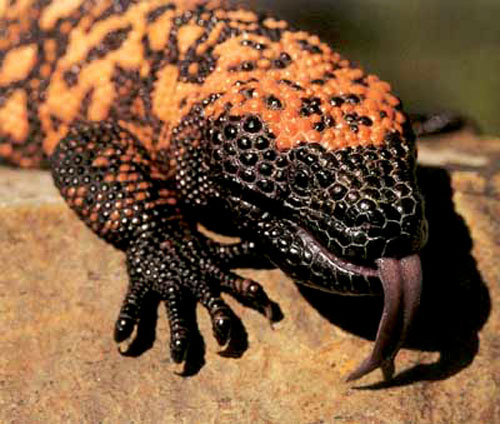The Gila Monster (Heloderma suspectum) is a species of lizard found in North America. It is one of the very few venomous lizards in the world.
Physical Features
The Gila monster is a stout lizards and can reach lengths of 2 feet. They have a rounded head and their body has patches of orange, yellow and black which helps it camouflage in the desert environment. They have powerful limbs with long claws while their tail is fat and short. They can weigh anywhere between 300 grams to 700 grams while the largest specimen reported was 2.3 kilograms.
Venom
The Gila Monster is one of the two venomous lizards of North America, the other one being the Beaded lizard. The Gila monster's venom is a neurotoxin and is said to be as toxic as a coral snake's venom. However a bite delivered from the Gila Monster to an adult, healthy human is not fatal as it produces the venom in very minute quantities. There are no reported cases of human deaths from Gila monster bites. The venom of a Gila monster is found to have proteins which are effective in the treatment of type-2 diabetes.
Distribution and Habitat
The Gila Monster is confined to the south western parts of the United Sates of America and the north western parts of Mexico. They inhabit dry grasslands, foothills of mountains and succulent desert.
Diet
The Gila monster mainly feeds on the eggs of birds and reptiles. They also feed on insects and small mammals.
Behavior
The Gila monster Changes its time of activity depending upon the season and temperatures. It spends most of its time burrowing. It is generally sluggish and shy which is why there are not many cases of Gila monster bites.
Conservation Status
The Gila monster is rated as 'Near Threatened' by the IUCN. It has suffered a population decline over the past couple of decades. It faces threats from habitat destruction and illegal pet trading. Large parts of their habitat has disappeared due to urbanization and agriculture.
Pic 1

